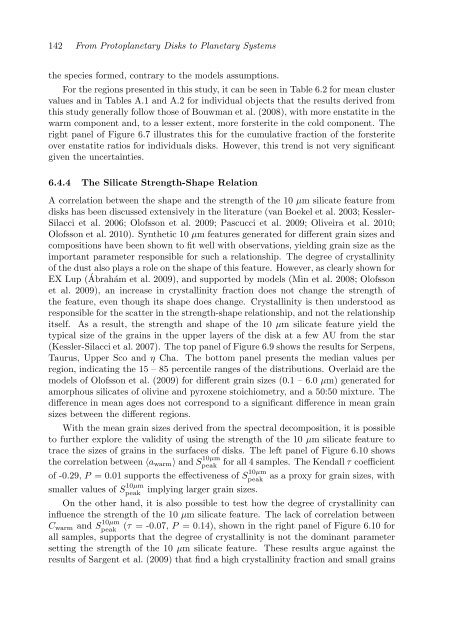Observational Constraints on The Evolution of Dust in ...
Observational Constraints on The Evolution of Dust in ...
Observational Constraints on The Evolution of Dust in ...
Create successful ePaper yourself
Turn your PDF publications into a flip-book with our unique Google optimized e-Paper software.
142 From Protoplanetary Disks to Planetary Systems<br />
the species formed, c<strong>on</strong>trary to the models assumpti<strong>on</strong>s.<br />
For the regi<strong>on</strong>s presented <strong>in</strong> this study, it can be seen <strong>in</strong> Table 6.2 for mean cluster<br />
values and <strong>in</strong> Tables A.1 and A.2 for <strong>in</strong>dividual objects that the results derived from<br />
this study generally follow those <strong>of</strong> Bouwman et al. (2008), with more enstatite <strong>in</strong> the<br />
warm comp<strong>on</strong>ent and, to a lesser extent, more forsterite <strong>in</strong> the cold comp<strong>on</strong>ent. <strong>The</strong><br />
right panel <strong>of</strong> Figure 6.7 illustrates this for the cumulative fracti<strong>on</strong> <strong>of</strong> the forsterite<br />
over enstatite ratios for <strong>in</strong>dividuals disks. However, this trend is not very significant<br />
given the uncerta<strong>in</strong>ties.<br />
6.4.4 <strong>The</strong> Silicate Strength-Shape Relati<strong>on</strong><br />
A correlati<strong>on</strong> between the shape and the strength <strong>of</strong> the 10 µm silicate feature from<br />
disks has been discussed extensively <strong>in</strong> the literature (van Boekel et al. 2003; Kessler-<br />
Silacci et al. 2006; Ol<strong>of</strong>ss<strong>on</strong> et al. 2009; Pascucci et al. 2009; Oliveira et al. 2010;<br />
Ol<strong>of</strong>ss<strong>on</strong> et al. 2010). Synthetic 10 µm features generated for different gra<strong>in</strong> sizes and<br />
compositi<strong>on</strong>s have been shown to fit well with observati<strong>on</strong>s, yield<strong>in</strong>g gra<strong>in</strong> size as the<br />
important parameter resp<strong>on</strong>sible for such a relati<strong>on</strong>ship. <strong>The</strong> degree <strong>of</strong> crystall<strong>in</strong>ity<br />
<strong>of</strong> the dust also plays a role <strong>on</strong> the shape <strong>of</strong> this feature. However, as clearly shown for<br />
EX Lup (Ábrahám et al. 2009), and supported by models (M<strong>in</strong> et al. 2008; Ol<strong>of</strong>ss<strong>on</strong><br />
et al. 2009), an <strong>in</strong>crease <strong>in</strong> crystall<strong>in</strong>ity fracti<strong>on</strong> does not change the strength <strong>of</strong><br />
the feature, even though its shape does change. Crystall<strong>in</strong>ity is then understood as<br />
resp<strong>on</strong>sible for the scatter <strong>in</strong> the strength-shape relati<strong>on</strong>ship, and not the relati<strong>on</strong>ship<br />
itself. As a result, the strength and shape <strong>of</strong> the 10 µm silicate feature yield the<br />
typical size <strong>of</strong> the gra<strong>in</strong>s <strong>in</strong> the upper layers <strong>of</strong> the disk at a few AU from the star<br />
(Kessler-Silacci et al. 2007). <strong>The</strong> top panel <strong>of</strong> Figure 6.9 shows the results for Serpens,<br />
Taurus, Upper Sco and η Cha. <strong>The</strong> bottom panel presents the median values per<br />
regi<strong>on</strong>, <strong>in</strong>dicat<strong>in</strong>g the 15 – 85 percentile ranges <strong>of</strong> the distributi<strong>on</strong>s. Overlaid are the<br />
models <strong>of</strong> Ol<strong>of</strong>ss<strong>on</strong> et al. (2009) for different gra<strong>in</strong> sizes (0.1 – 6.0 µm) generated for<br />
amorphous silicates <strong>of</strong> oliv<strong>in</strong>e and pyroxene stoichiometry, and a 50:50 mixture. <strong>The</strong><br />
difference <strong>in</strong> mean ages does not corresp<strong>on</strong>d to a significant difference <strong>in</strong> mean gra<strong>in</strong><br />
sizes between the different regi<strong>on</strong>s.<br />
With the mean gra<strong>in</strong> sizes derived from the spectral decompositi<strong>on</strong>, it is possible<br />
to further explore the validity <strong>of</strong> us<strong>in</strong>g the strength <strong>of</strong> the 10 µm silicate feature to<br />
trace the sizes <strong>of</strong> gra<strong>in</strong>s <strong>in</strong> the surfaces <strong>of</strong> disks. <strong>The</strong> left panel <strong>of</strong> Figure 6.10 shows<br />
the correlati<strong>on</strong> between 〈a warm 〉 and S 10µm<br />
peak<br />
<strong>of</strong> -0.29, P = 0.01 supports the effectiveness <strong>of</strong> S 10µm<br />
peak<br />
smaller values <strong>of</strong> S 10µm<br />
peak<br />
imply<strong>in</strong>g larger gra<strong>in</strong> sizes.<br />
for all 4 samples. <strong>The</strong> Kendall τ coefficient<br />
as a proxy for gra<strong>in</strong> sizes, with<br />
On the other hand, it is also possible to test how the degree <strong>of</strong> crystall<strong>in</strong>ity can<br />
<strong>in</strong>fluence the strength <strong>of</strong> the 10 µm silicate feature. <strong>The</strong> lack <strong>of</strong> correlati<strong>on</strong> between<br />
C warm and S 10µm<br />
peak<br />
(τ = -0.07, P = 0.14), shown <strong>in</strong> the right panel <strong>of</strong> Figure 6.10 for<br />
all samples, supports that the degree <strong>of</strong> crystall<strong>in</strong>ity is not the dom<strong>in</strong>ant parameter<br />
sett<strong>in</strong>g the strength <strong>of</strong> the 10 µm silicate feature. <strong>The</strong>se results argue aga<strong>in</strong>st the<br />
results <strong>of</strong> Sargent et al. (2009) that f<strong>in</strong>d a high crystall<strong>in</strong>ity fracti<strong>on</strong> and small gra<strong>in</strong>s
















